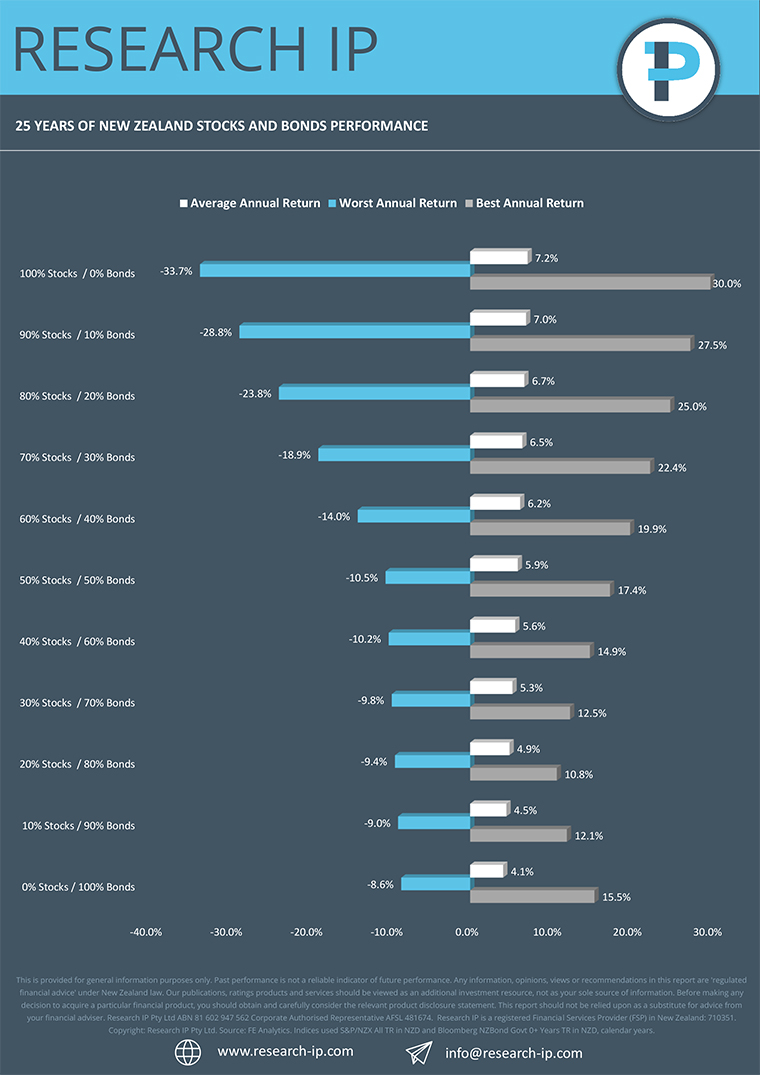
In the last 25 years there has only been one year where both stocks and bonds have returned negative performances in the same year (using New Zealand index returns). Last year was the first year this has occurred.

We wrote in an earlier article, “…Asset allocation is the main driver of returns over time so this is where much focus should be paid to ensure an investor’s portfolio is commensurate with their risk tolerance.”
The graphic above and table below show the difference in portfolio returns between various combinations of stocks and bonds. If you had invested 100% of your investment portfolio in bonds then you would have averaged 4.1% per annum over the last 25 years. A portfolio of 60% stocks / 40% bonds would have averaged 6.2% per annum, and a portfolio of 100% stocks would have averaged 7.2% per annum. To put this in dollar terms the portfolios would have returned approximately $334,950 versus $612,727 versus $794,909 over the 25-year period.
|
Stock/Bonds Portfolio Allocation |
Best Annual Return |
Worst Annual Return |
Average Annual Return |
|
0% Stocks / 100% Bonds |
15.5% |
-8.6% |
4.1% |
|
10% Stocks / 90% Bonds |
12.1% |
-9.0% |
4.5% |
|
20% Stocks / 80% Bonds |
10.8% |
-9.4% |
4.9% |
|
30% Stocks / 70% Bonds |
12.5% |
-9.8% |
5.3% |
|
40% Stocks / 60% Bonds |
14.9% |
-10.2% |
5.6% |
|
50% Stocks / 50% Bonds |
17.4% |
-10.5% |
5.9% |
|
60% Stocks / 40% Bonds |
19.9% |
-14.0% |
6.2% |
|
70% Stocks / 30% Bonds |
22.4% |
-18.9% |
6.5% |
|
80% Stocks / 20% Bonds |
25.0% |
-23.8% |
6.7% |
|
90% Stocks / 10% Bonds |
27.5% |
-28.8% |
7.0% |
|
100% Stocks / 0% Bonds |
30.0% |
-33.7% |
7.2% |
However, the variation in returns in these 25 years would have been significant. Over the past 25 years, bonds have posted negative calendar year returns 12% of the time, a 60/40 portfolio 16% of the time, and stocks 20% of the time.
A 60/40 portfolio had its worst return in 2008, returning -14% during the Global Financial Crisis. A portfolio invested 100% in stocks would have returned -33.7% in its worst year (also 2008), whilst 100% in bonds would have returned -8.6% (in 2022). Not insignificant!
An investor’s time horizon for investing is enormously important to consider when deciding their appropriate risk profile and commensurate asset allocation split. When markets fluctuate more widely, the timing and order of returns are of more concern, particularly for investors that have liquidity needs from their portfolios.
We reiterate that ongoing governance and portfolio reviews are important to make sure the drivers of risk and return within the portfolio are appropriate for investors’ objectives.
Research IP’s key considerations for investors today:
- Be honest when assessing your risk profile.
- Stay the course; chasing investment performance often leads to being in the wrong asset class.
- Volatility has returned to the market.
- Inflation is likely to remain persistent, but at what level is not clear.
- Avoid the noise; it is an investor’s enemy, causing rash decisions to be made.
Andy Mahony is an investment consultant at Research IP. You can contact him here. As a resource for investors, the RIPPL Effect reports for over 200 funds are available here.
9 Comments
Hear what you say but at some point one has to change - I don't plan to live poor just so I can die with an intact portfolio. So if I planned to start to move funds down the risk scale it is surely a matter of luck whether my timing hits a positive or negative period? The level needed for forward planning and ability to assess risk of timing or to have other financial means available to allow for delay in what otherwise had been the anticipated timeline is probably beyond 90% plus of investors. So they either get caught out or do not take the risk of volatility at all?
I remember back in the Telecom days when it was included in the NZ50 and slowly but surely dragged to whole index lower. Simply dropping Telecom from the NZ50 and having the other 49 would have returned 30%-60% more each year. Better still - dropping some of the other dogs in the NZ50 that were dragging it down and eventually exited, and focusing just on the remaining 35'ish would have done you very well indeed. All you needed to do was to chart the share price once a month using some basic indicators and be ruthless about selling when they hit a downtrend - and conversely buy when the downtrends reversed. (Note I said 'when the down trend reversed' - not when an uptrend became established.)
That is certainly a plausible active approach to investing, but hard to replicate the exact stock weightings for the average investor, perhaps? What would be your metrics to identify those non-performing companies in advance? What length of time constitutes a downtrend? For your interest, the data in this article is using the NZX All Index.
Gold is a good measure of currency debasement over time. This flows through to asset prices (e.g. the gold bumps correspond well with house price changes). Stocks will also have dividends and re-investing these would add about 3%/year more to the returns - change the drop down on the graph here to see the difference for US stocks IndexView - Long Term S&P 500 Viewer (thume.ca). NZ's improvement will likely be higher as yield here is higher.
The quality of financial analysis in NZ is poor compared to other markets. This looks like a really basic analysis and leaves a lot of questions. Do these returns include dividends/income? Are dividends reinvested? Are they real returns? What if you invest like a real person by putting in money each month which dollar cost averages the returns? Not many people have a lump sum to invest for 25 years then add nothing else to it.
The only conclusions from this are that higher risk assets perform better over longer time periods and diversification performs better than the sum of its parts.
Most people will also struggle with compounding returns. Over 25 years, 7.6%/year returns 624% vs 4.1%/year which returns 273% - so you will earn 2.3 times more.
All valid questions. This is definitely a simple analysis and your conclusions are correct. To answer your questions one by one: yes, yes, no they are nominal returns, and regarding dollar cost averaging we talk about sequencing risks in another article which is linked into this one.

We welcome your comments below. If you are not already registered, please register to comment.
Remember we welcome robust, respectful and insightful debate. We don't welcome abusive or defamatory comments and will de-register those repeatedly making such comments. Our current comment policy is here.